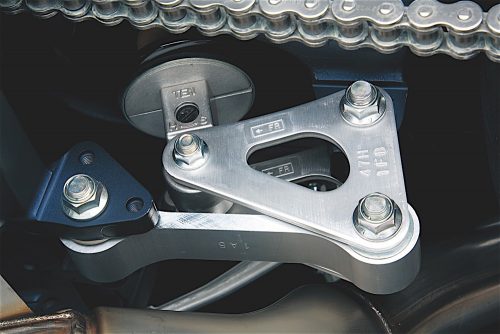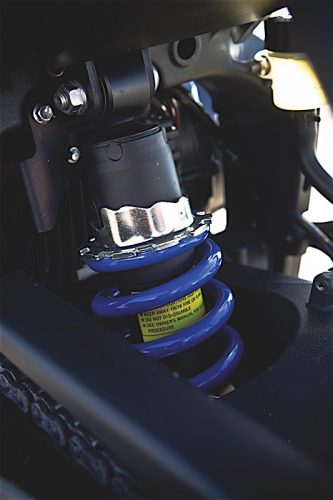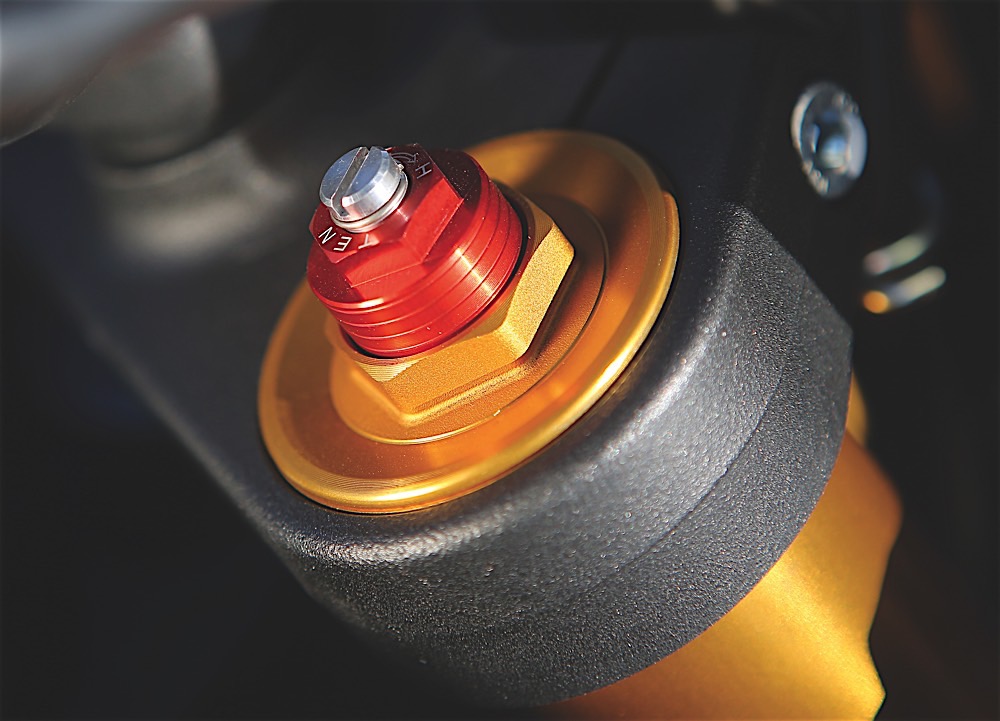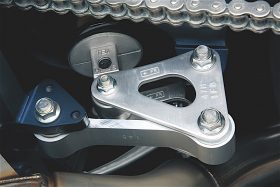Motorcycle suspension varies from the simplest oil-damped, non-adjustable fork and shock, to the latest electronically controlled active systems that sense road and riding conditions and, to a varying degree, self-adjust. In the last issue, we discussed chassis geometry and why it determines how your bike handles. Here, we’ll tell you how the suspension affects handling and how to adjust it (if it is adjustable) to improve handling.
 Motorcycle suspension is designed to absorb bumps and make the ride more comfortable; it compresses to absorb a bump, and a spring returns it to its original position. Oil is used to slow down and control that spring rebound, and to a lesser extent, its compression. But the suspension is limited in just how well it can do its job, because engineers will tune it to fit a wide range of rider weights. If you’re lucky, your weight fits right in the middle of the weight range your suspension was designed for; if not, you will find that it might be too soft or too firm.
Motorcycle suspension is designed to absorb bumps and make the ride more comfortable; it compresses to absorb a bump, and a spring returns it to its original position. Oil is used to slow down and control that spring rebound, and to a lesser extent, its compression. But the suspension is limited in just how well it can do its job, because engineers will tune it to fit a wide range of rider weights. If you’re lucky, your weight fits right in the middle of the weight range your suspension was designed for; if not, you will find that it might be too soft or too firm.
The minimal adjustment you will find on most motorcycles is the spring preload, usually at the rear and sometimes at the front. The spring is preload adjustable to help maintain the ideal ride height once the bike is loaded, but also to ensure that the suspension is working within its ideal stroke travel; compress the suspension too much and it will bottom out, not enough and it will top out. Even without luggage or a passenger, your own weight might compress the rear end enough to affect steering, which will get slower and require more effort. Maintaining the proper ride height by adjusting the preload ensures it will handle as it was designed, while also maintaining the appropriate cornering clearance.
 To achieve the proper ride height, you must measure the suspension sag. Suspension sag is the amount the suspension compresses from its normal, unladen position when the rider mounts. A rough gauge for sag adjustment is that the front and rear suspension should compress no more than one third of its travel once the rider is seated. With the suspension-travel spec in hand, readily found online or in the owner’s manual, you can check the fork sag using a zip tie. When the fork is fully extended, attach the zip tie with moderate tension around the male slider at the fork seal. Then, as you sit on the bike, the fork will compress, pushing the zip tie against the fork seal and moving it on the fork tube. If the zip tie is snug enough, it will stay in place, and you will be able to measure its distance travelled when you get off the bike. The rear must be recorded with a tape measure, so you’ll need an assistant’s help.
To achieve the proper ride height, you must measure the suspension sag. Suspension sag is the amount the suspension compresses from its normal, unladen position when the rider mounts. A rough gauge for sag adjustment is that the front and rear suspension should compress no more than one third of its travel once the rider is seated. With the suspension-travel spec in hand, readily found online or in the owner’s manual, you can check the fork sag using a zip tie. When the fork is fully extended, attach the zip tie with moderate tension around the male slider at the fork seal. Then, as you sit on the bike, the fork will compress, pushing the zip tie against the fork seal and moving it on the fork tube. If the zip tie is snug enough, it will stay in place, and you will be able to measure its distance travelled when you get off the bike. The rear must be recorded with a tape measure, so you’ll need an assistant’s help.
Adjusting the preload doesn’t mean the suspension can carry more weight; it means it will carry that weight higher up in the damper’s stroke. The spring rate determines how much weight a spring can handle, and that will not change, regardless of the sag setting.
As mentioned, hydraulic damping slows how quickly the suspension will compress and rebound, and without it, the suspension would continue to bounce up and down for several oscillations after hitting a bump. Not only would this be annoying, and possibly nauseating, it would also be dangerous, especially when leaning into a turn, because it would cause the bike to weave about instead of maintaining a steady line. The rebound damping at the rear, slowing the extension of the suspension back to its original position, controls this oscillation. An indication that a bike is under-damped is a wallowing in the rear when cornering. If no adjustment is provided, there’s not much to do about this condition other than look into an aftermarket shock absorber (or if your bike has high mileage, a new OEM shock, sometimes available separately from the spring to reduce cost).
If your bike is equipped with adjustable rebound, easily identified by an adjustment screw at the bottom of the shock, find a familiar corner, preferably a long one on an infrequently travelled road, and gradually turn the adjuster in one click at a time (or a quarter turn if it has no click stops) to make it harder. You’ve reached the right setting as soon as the bike stops wallowing through the turn. There’s no need to go further than this setting, because if you get the damping too slow, the rear end might squat after hitting repeated bumps, which will reduce cornering clearance until the rear comes back up again.
Some shocks might have another adjustment screw at the top; this is the compression damping adjuster. Unless you participate in track days or enjoy fast sporting rides on winding roads, this adjustment is almost redundant. It is meant to control the compression of the rear suspension, especially when transitioning through consecutive turns. A road racer doesn’t want the rear to squat too quickly when leaning into a corner, and uses this adjustment to control this. On the street, the more compression damping you introduce into the suspension, the harsher it will feel. When I ride a bike on the street, I usually set this to the minimum for the most comfortable ride.
Forks might also be adjustable, and I apply the same rules to damping adjustment, and usually at a standstill. I start by backing off the adjustments to the minimum and turning the rebound adjuster incrementally (this is usually found at the top of each fork tube, but check your owner’s manual) until I feel a slight resistance on the rebound. I leave the compression damping alone unless I intend to hit the racetrack.
If no adjustment is available and you find the fork on your bike either too springy or too harsh, you can alter its damping characteristics by replacing the fork oil with either a heavier or lighter oil, depending on whether you wish to firm up or to soften damping. Note that you should make small changes, like going up or down by a factor of five (for example, 10 weight to 15 weight).
The goal when adjusting damping is to use the minimum amount that will eliminate wallowing. Any more is unnecessary, unless you load the bike with a passenger or luggage, which will require perhaps another preload adjustment, as well as a slight increase in damping.
For general street riding, I usually set the front and rear compression damping, if available, to its minimum setting, and dial in just enough rebound to eliminate the wallowing in corners.
Technical articles are written purely as reference only and your motorcycle may require different procedures. You should be mechanically inclined to carry out your own maintenance and we recommend you contact your mechanic prior to performing any type of work on your bike.












